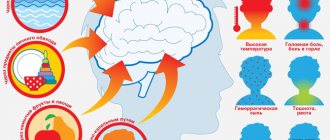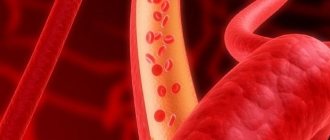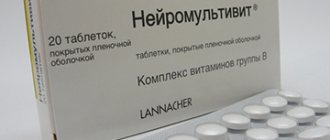In this process, a significant obstacle to the transfer of substances from the blood to the nervous tissue is the layer of endothelial cells of the brain capillaries. The capillaries of the brain have a specific structure that distinguishes them from the capillaries of other organs. The distribution density of capillaries per unit area in various brain tissues is also important.
Rrontoft (1955), using isotopes of phosphorus (P32) and semi-colloidal gold (Au198), in an experiment on rabbits showed that the amount of the substance that penetrated into the brain is proportional to the area of the capillary bed, i.e., the main membrane separating blood and nervous tissue.
The hypothalamic region of the brain has the richest and most extensive capillary network. Thus, according to N.I. Grashchenkov, the nuclei of the oculomotor nerve have 875 capillaries per 1 mm, the area of the calcarine sulcus of the occipital lobe of the cerebral cortex - 900, the nuclei of the hypothalamus - 1100-1150, the paraventricular nuclei - 1650, the supraoptic - 2600. The permeability of the blood-brain barrier in hypothalamic region is slightly higher than in other parts of the brain. The high density of capillaries and their increased permeability in the brain region associated with visual functions creates favorable conditions for metabolism in the nervous tissue of the visual pathway.
The intensity of the functioning of the BBB can be judged by the ratio of the content of various substances in brain tissue and cerebrospinal fluid. Much data about the BBB was obtained from studying the penetration of various substances from the blood into the cerebrospinal fluid. It is known that cerebrospinal fluid is formed both due to the functioning of the choroid plexus and due to the ependyma of the ventricles of the brain. N. Davson et al. (1962) showed that the ionic composition of the cerebrospinal fluid is identical to that of the aqueous space of the brain. It has also been shown that some substances introduced into the cerebrospinal fluid enter and are distributed in the brain tissues not diffusely, but along certain anatomical pathways, highly dependent on the density of the capillary network and the characteristics of metabolism in individual functional areas of the brain.
The barrier structures of the brain are also vascular and cellular membranes formed by two lipid layers of adsorbed proteins. In this regard, the solubility coefficient of substances in lipid fats is of decisive importance in the passage through the BBB. The speed of the narcotic action of general anesthetics is directly proportional to the coefficient of solubility in lipids (Meyer-Overton law). Undissociated molecules penetrate the BBB faster than highly tonic substances and ions with low lipid solubility. For example, potassium passes through the BBB more slowly than sodium and bromine.
Original studies on the functional morphology of the blood-brain barrier were carried out by G. G. Avtandilov (1961) in an experiment on dogs. Using the method of double salt injections into the common carotid artery and lateral ventricles of the brain, he showed that electrolytes introduced into the blood were found in the intercellular spaces and the basement membrane of the epithelium of the choroid plexuses of the brain within a few minutes. Electrolytes were also found in the ground substance of the stroma of the choroid plexuses.
S. Rapoport (2001) experimentally determined the state of the BBB by introducing a hypertonic solution of arabinose or mannitol into the carotid artery. After administration for 10 minutes, a 10-fold increase in barrier permeability was noted. The duration of increased barrier permeability can be increased to 30 minutes if pre-treatment is carried out with substances that block Ka+/Ca2+ channels.
The endothelial cells of the blood capillaries of the brain, with the participation of astrocytes, form tight junctions that prevent the passage of substances dissolved in the blood (electrolytes, proteins) or cells. The BBB is absent in the posterior lobe of the pituitary gland, the posteriormost field of the rhomboid fossa, the choroid plexus, and the periventricular organs. The BBB separates the extracellular environment of the brain from the blood and protects nerve cells from changes in the concentration of electrolytes, neurotransmitters, hormones, growth factors and immune responses. In a number of diseases, the formation of tight junctions between BBB cells is disrupted. This occurs, for example, in brain tumors that do not contain functional astrocytes. BBB permeability increases with hyperosmolarity caused by intravenous administration of hypertonic mannitol solutions or with bacterial meningitis.
The blood-brain barrier in newborns is not formed. Therefore, with hyperbilirubinemia in a newborn, bilirubin enters the brain and damages the nuclei of the brain stem (kernicterus). Damage to the basal ganglia leads to hyperkinesis.
The peripheral nerve system is not protected by the blood-brain barrier. In autoimmune diseases, the roots of the spinal nerves (Guillain-Barre syndrome) and neuromuscular synapses (myasthenia gravis, myasthenic syndrome) are affected.
Central regulation of blood supply to the brain
Almost all parts of the central nervous system are involved in regulating the functioning of the cardiovascular system.
There are three main levels of such regulation.
- Stem of the hypothalamus.
- The influence of certain areas of the cerebral cortex.
1. “Stem centers.” In the medulla oblongata, in the region of the reticular formation and in the bulbar sections of the pons, there are formations that together constitute the stem (medullary) and rhomboencephalic circulatory centers.
2. “Centers” of the hypothalamus. Irritation of the reticular formation in the midbrain and diencephalon (hypothalamic region) can have both a stimulating and inhibitory effect on the cardiovascular system. These effects are mediated through stem centers.
3. The influence of certain areas of the cerebral cortex. Blood circulation is influenced by parts of the cortex of two areas: a) neocortex; b) paleocortex. Brain tissue is extremely sensitive to decreased cerebral blood flow. If cerebral blood flow completely stops, then within 4 s individual disturbances in brain function are detected, and after 8-12 s there is a complete loss of its functions, accompanied by loss of consciousness. On the EEG, the first disturbances are recorded after 4-6 s; after 20-30 s, the spontaneous electrical activity of the brain disappears completely. With ophthalmoscopy, areas with red blood cell aggregations are identified in the retinal veins. This is a sign of cessation of cerebral blood flow.
Autoregulation of cerebral circulation
The constancy of cerebral blood flow is ensured by its autoregulation during changes in perfusion pressure. In cases of increased blood pressure, the small arterial vessels of the brain narrow; when the pressure decreases, on the contrary, they expand. If systemic arterial pressure tends to increase stepwise, cerebral blood flow initially increases. However, then it decreases almost to its original value, despite the fact that blood pressure continues to remain high. Such autoregulation and constancy of cerebral blood flow during fluctuations in blood pressure within certain limits are carried out mainly by myogenic mechanisms, in particular the Baylis effect. This effect consists of direct contractile reactions of the smooth muscle fibers of the cerebral arteries in response to varying degrees of stretching by arterial intravascular pressure. An autoregulatory reaction is also inherent in the vessels of the cerebral venous system.
With various pathologies, a violation of the autoregulation of cerebral circulation may be observed. Severe stenosis of the internal carotid artery with a rapid drop in systemic blood pressure by 20-40 mmHg. Art. lead to a decrease in blood flow velocity in the middle cerebral artery by 20-25%. In this case, the return of blood flow velocity to the initial level occurs only after 20-60 s. Under normal conditions, this return occurs within 5-8 seconds.
Thus, autoregulation of cerebral blood flow is one of the most important features of cerebral circulation. Thanks to the phenomenon of autoregulation, the brain, as a complex integral organ, can function at the most favorable, optimal level.
Functions of the blood-brain barrier
The blood-brain barrier performs a number of functions.
Protective
consists in delaying the access from the blood to the nervous tissue of various substances that can have a damaging effect on the brain.
Regulatory function
is to maintain the composition and constancy of cerebrospinal fluid. Even with changes in blood composition, cerebrospinal fluid constants do not change.
The BBB works as a selective filter,
allowing some substances into the cerebrospinal fluid and not others, which can circulate in the blood but are foreign to the brain tissue. Thus, adrenaline, norepinephrine, acetylcholine, dopamine, serotonin, gamma-aminobutyric acid (GABA), penicillin, streptomycin do not pass through the BBB. Bilirubin is always in the blood, but never, even with jaundice, does it pass into the brain, leaving only the nervous tissue unstained. Therefore, it is difficult to obtain an effective concentration of any drug to reach the brain parenchyma. Morphine, atropine, bromine, strychnine, caffeine, ether, urethane, alcohol and gamma-hydroxybutyric acid (GHB) pass through the BBB. When treating, for example, tuberculous meningitis, streptomycin is injected directly into the cerebrospinal fluid, bypassing the barrier using a lumbar puncture.
It is necessary to take into account the unusual action of many substances injected directly into the cerebrospinal fluid. Trypan blue, when injected into the cerebrospinal fluid, causes convulsions and death; bile has a similar effect. Acetylcholine, injected directly into the brain, acts as an adrenomimetic, and adrenaline, on the contrary, as a cholinomimetic: blood pressure decreases, bradycardia occurs, body temperature first decreases and then increases. It causes narcotic sleep, lethargy and analgesia. K + ions act as a sympathomimetic, and Ca 2+ is a para-sympathomimetic. Lobelia is a reflex stimulator of breathing, penetrating the blood-brain barrier and causing a number of adverse reactions (dizziness, vomiting, convulsions). Insulin, when administered intramuscularly, reduces blood sugar, and when injected directly into the cerebrospinal fluid, it increases it.
The protective function of the BBB is less developed at the time of birth and at an early age, forming in the postnatal period. Therefore, a child with various diseases often experiences convulsions and a significant increase in body temperature, which indicates the easy penetration of toxic substances into the cerebrospinal fluid; such phenomena are not observed in an adult.
Regulation of cerebral circulation during fluctuations in blood gas composition
There is a clear correlation between cerebral blood flow and changes in blood gas composition (oxygen and carbon dioxide). The stability of maintaining normal gas content in brain tissue is of great importance. With an excess of carbon dioxide and a decrease in oxygen content in the blood, an increase in cerebral blood flow occurs. With hypocapnia and (hyperoxia) an increase in oxygen content in the blood, a weakening of cerebral blood flow is observed. Inhalation of a mixture of oxygen with 5% CO2 is widely used in the clinic as a functional test. It has been established that the maximum increase in blood flow velocity in the middle cerebral artery during hypercapnia (increased blood carbon dioxide content) can reach 50% compared to the initial level. The maximum reduction in blood flow velocity (up to 35%) compared to the initial level is achieved with hyperventilation and a decrease in carbon dioxide tension in the blood. There are a number of methods for determining local cerebral blood flow (radiological methods, hydrogen clearance techniques using electrodes implanted in the brain). After R. Aaslid first used transcranial Doppler sonography in 1987 to study changes in cerebral hemodynamics in the great vessels of the brain, this method has found wide application for determining blood flow in vessels. With a lack of oxygen and a decrease in its partial pressure in the blood, vasodilation occurs, in particular arterioles. Dilatation of cerebral vessels also occurs with a local increase in carbon dioxide content and (or) concentration of hydrogen ions. Lactic acid also has a vasodilating effect. Pyruvate has a weak vasodilating effect, while ATP, ADP, AMP and adenosine have a strong vasodilating effect.
Metabolic regulation of cerebral circulation
Numerous studies have established that the higher and more intense the metabolism in a particular organ, the greater the blood flow in its vessels. This is accomplished due to changes in resistance to blood flow by expanding the lumen of blood vessels. In such a vital organ as the brain, whose need for oxygen is extremely high, blood flow is maintained at an almost constant level.
The basic principles of the metabolic regulation of cerebral blood flow were formulated by Roy and Sherrinton back in 1890. Subsequently, it was proven that under normal conditions there is a close connection and correlation between the activity of neurons and local cerebral blood flow in this area. Currently, a clear dependence of cerebral blood flow on changes in the functional activity of the brain and mental activity of a person has been established.
Using the properties of the BBB in pharmacology
Modern effective medications are developed taking into account the permeability of the blood-brain barrier. For example, the pharmaceutical industry produces synthetic analgesics based on morphine. But unlike it, drugs do not pass through the BBB. Thanks to this, medications effectively relieve pain without making the patient morphine dependent. There are various antibiotics that cross the blood-brain barrier. Many of them are considered indispensable in the treatment of certain infectious pathologies. It must be remembered that an overdose of drugs can provoke serious complications - paralysis and nerve death. In this regard, experts strongly discourage self-medication with antibiotics.
Nervous regulation of cerebral circulation
Nervous regulation of the lumen of blood vessels is carried out using the autonomic nervous system.
Neurogenic mechanisms take an active part in various types of regulation of cerebral blood flow. They are closely related to autoregulation, metabolic and chemical regulation. In this case, irritation of the corresponding baroreceptors and chemoreceptors is important. Efferent fibers going to the brain vessels end in axon terminals. These axons are in direct contact with the smooth muscle fiber cells of the pial arteries, which provide blood circulation to the cerebral cortex. In the cerebral cortex, blood supply, metabolism and functions are extremely closely connected. Sensory stimulation causes an increase in blood flow in the cortical sections of those analyzers where afferent impulses are addressed. The correlation between brain function and cerebral blood flow, manifested at all levels of the structural organization of the cortex, is realized through the system of pial vessels. A highly branched network of pial vessels is the main link providing adequate local blood circulation to the cerebral cortex.
BBB or blood-brain barrier: its structure and significance
1. What is the BBB? 2. A little history 3. The structure and functions of the barrier 4. Where there are no barriers 5. When permeability is impaired
It is no secret that the body must maintain the constancy of its internal environment, or homeostasis, expending energy for this, otherwise it will not differ from inanimate nature. Thus, the skin protects our body from the outside world at the organ level.
But it turns out that other barriers that form between the blood and certain tissues are also important. They are called histohematic. These barriers are necessary for various reasons. Sometimes it is necessary to mechanically limit the penetration of blood into tissues. Examples of such barriers are:
- blood-articular barrier - between blood and articular surfaces;
- blood-ophthalmic barrier - between the blood and the light-conducting media of the eyeball.
Everyone knows from their own experience that when cutting meat it is clear that the surface of the joints is always deprived of contact with blood. If blood flows into the joint cavity (hemarthrosis), it contributes to its overgrowth, or ankylosis. It is clear why a blood-ophthalmic barrier is needed: inside the eye there are transparent media, for example, the vitreous humor. Its task is to absorb passing light as little as possible. If there is no this barrier, then the blood will penetrate into the vitreous body, and we will be deprived of the ability to see.
Tissue respiration of the brain
The normal functioning of the human brain is associated with the consumption of a significant amount of biological energy. This energy comes mainly from the oxidation of glucose. Glucose is a monosaccharide from the group of aldohexoses that are part of polysaccharides and glycoproteins. It is one of the main sources of energy in the animal body. Glycogen is a constant source of glucose in the body. Glycogen (animal sugar) is a high molecular weight polysaccharide built from glucose molecules. It is a reserve of carbohydrates in the body. Glucose is a product of complete hydrolysis of glycogen. Blood entering the brain delivers the necessary amount of glucose and oxygen to the tissues. Normal brain functioning occurs only with a constant supply of oxygen.
Glycolysis is a complex enzymatic process of glucose breakdown that occurs in tissues without oxygen consumption. This produces lactic acid, ATP and water. Glycolysis is a source of energy under anaerobic conditions.
Functional disorders in brain activity also occur when there is insufficient amount of glucose in the blood. You should be careful when administering insulin to patients, since the wrong dosage when administering the drug can lead to hypoglycemia with loss of consciousness.
The rate of oxygen consumption by the brain is on average 3.5 ml/100 g of tissue per 1 min. The rate of glucose consumption by the brain is 5.5 ml/100 g of tissue per 1 min. The brain of a healthy person receives energy mainly exclusively from the oxidation of glucose. More than 90% of glucose utilized by the brain undergoes aerobic oxidation. Glucose is eventually oxidized to carbon dioxide, ATP and water. With a lack of oxygen in the tissues, the value of anaerobic glycolysis increases, its intensity can increase 4-7 times.
The anaerobic metabolic pathway is less economical compared to aerobic metabolism. The same amount of energy can be obtained from anaerobic metabolism, breaking down 15 times more glucose than from aerobic metabolism. In aerobic metabolism, the breakdown of 1 mole of glucose produces 689 kcal, which equals 2883 kJ of free energy. In anaerobic metabolism, the breakdown of 1 mole of glucose produces only 50 kcal, which equals 208 kJ of free energy. However, despite the small energy output, anaerobic breakdown of glucose plays a role in some tissues, in particular in retinal cells. At rest, oxygen is actively absorbed by the gray matter of the brain. The white matter of the brain consumes less oxygen. Using positron emission tomography, it was found that gray matter absorbs oxygen 2-3 times more intensely than white matter.
In the cerebral cortex, the distance between adjacent capillaries is 40 µm. The density of capillaries in the cerebral cortex is five times higher than in the white matter of the cerebral hemispheres.
Under physiological conditions, hemoglobin oxygen saturation is about 97%. Therefore, if it is necessary to increase the oxygen demand of an organ, oxygen delivery is possible mainly by increasing the speed of blood flow. With increased brain activity, oxygen delivery to it increases mainly as a result of a decrease in muscle tone of the vascular walls. The expansion of brain vessels is facilitated by a decrease in oxygen tension (hypoxia), as well as an increase in carbon dioxide tension in the intracellular and extracellular spaces and an increase in the concentration of hydrogen ions in the extracellular space.
However, the influence of all these factors decreases significantly with a decrease in the content of calcium ions in the perivascular space, which play a large role in ensuring the tone of blood vessels. A decrease in the concentration of calcium ions in the extracellular environment leads to dilation of blood vessels, and an increase leads to their narrowing.
The main component (up to 80%) of neuronal membranes and myelin are lipids. Damage to cell membranes is one of the triggers for the development of many pathological processes in various diseases of the visual pathway. In this case, free-apical oxidation and accumulation of lipid peroxidation products are observed both in the affected area and in the blood of patients. It has been established that the intensity of lipid peroxidation processes is inextricably linked with the state of the body's antioxidant system. In various diseases, when the balance between pro- and antioxidant processes is disturbed, destruction of the cell membrane and substance develops. Increased free radical oxidation of lipids is found in areas of hypoxia, with glaucoma, in the retina of the eye with excessive illumination and other pathological conditions of the visual pathway.
Medicines passing through the BBB
The blood-brain barrier is selectively permeable. Thus, some of the biologically active compounds - catecholamines, for example - do not pass the BBB. However, there are small areas near the pituitary gland, pineal gland, and several areas of the hypothalamus where these substances can cross the blood-brain barrier. When prescribing treatment, the doctor takes into account the characteristics of the BBB. For example, in practical gastroenterology, barrier permeability is taken into account in the process of assessing the intensity of the side effects of certain medications on the digestive organs. In this case, they try to give preference to those drugs that pass through the BBB less well. As for antibiotics, among those that penetrate the barrier well is o. It is also known as "McMirror". First generation prokinetic agents overcome the BBB well. These, in particular, include such drugs as “Bimaral”, “Metoclopramide”. The active substance in them is bromopride.
The next generation of prokinetic drugs also pass through the BBB well. Among them are such medications as “Motilak”, “Motilium”. The active substance in them is domperidone. Drugs such as Itomed and Ganaton penetrate the blood-brain barrier worse. The active ingredient in them is itopride. The best degree of passage through the BBB is observed with medications such as Ampicillin and Cefazolin. It should also be said that the ability to penetrate the blood-brain barrier is higher for fat-soluble compounds than for water-soluble ones.
Microcirculation of the brain
Microcirculation is understood as a set of processes of blood flow in the vessels of the microcirculatory (terminal) exchange between blood plasma and interstitial fluid, as well as the formation of lymph from interstitial fluid. It is in the capillaries (metabolic vessels) that the exchange of nutrients and products of cellular metabolism between tissues and circulating blood occurs.
Blood microcirculation consists of three main components:
- Microhemodynamics.
- Microrheology.
- Transcapillary (hematotic) exchange - exchange occurring through the wall of capillaries and post-capillary venules between blood and interstitial tissue fluid.
Lymphatic capillaries penetrate the tissues of almost all organs of the human body. However, they are absent in the brain, spinal cord, and optic nerve. All drainage from the brain and spinal cord occurs through the venous system. Various microcirculation disorders play an important role in the pathogenesis and clinical picture of many diseases of the visual pathway.
Cerebral circulatory disorders (ischemia)
Ischemia is a weakening of blood circulation in an organ or part of an organ due to a decrease in blood flow, leading to a defect in the blood supply to tissues. The response of the central nervous system to ischemia is expressed in excitation of the circulatory centers of the medulla oblongata, accompanied mainly by vasoconstriction. Cerebral circulation disorders can be general (heart disease, etc.) and local (ischemia, etc.) in nature. In this case, reversible and irreversible changes may occur in the tissues and cells of the brain or its individual parts. With oxygen deficiency, oxidative phosphorylation and, consequently, ATP synthesis are disrupted. The damage to the cell membrane that occurs is a critical moment for the development of irreversible (lethal) changes in the cell. A significant increase in the level of calcium in the cytoplasm is one of the main causes of biochemical and morphological changes leading to cell death.
Pathological changes in the pulpy nerve fiber of the white matter of the brain consist of changes in its two main elements - the myelin sheath and the axial cylinder. Regardless of the reason for the interruption of the nerve fiber, changes develop in its peripheral part, defined as Wallerian degeneration.
With a pronounced degree of ischemia, coagulative necrosis of the neuron (nerve cell) occurs. The anoxic (or homogenizing) change in the neuron is close to the ischemic one, since it is also based on the processes of cell coagulation. The death of brain neurons often accompanies the process of neuronophagy. In this case, leukocytes or gliocytes are introduced into the nerve cell, accompanied by phagocytosis processes.
Circulatory ischemic hypoxia is observed during ischemia. It can be acute and chronic. Ischemia can lead to the death of individual neurons or a group of neurons (incomplete necrosis) or to the development of infarction of individual areas of brain tissue (complete necrosis). The nature and severity of these pathological changes are directly dependent on the magnitude, duration and location of the cerebrovascular accident.
Compensatory-adaptive processes in the brain are poorly expressed. The regeneration processes of various brain tissues are very limited. This feature greatly aggravates the severity and circulatory disorders of brain tissue. Nerve cells and their axons do not regenerate. Separation processes are imperfect and occur with the participation of glia and mesenchymal elements. Adaptive and compensatory processes in the brain are carried out not so much through the restoration of damaged structures, but through various compensatory functional changes.
Structure
What is the structure of the blood-brain barrier? The main element is endothelial cells. The blood-brain barrier also includes astrocytes and pericytes. In cerebral vessels there are tight junctions between endothelial cells. The gaps between the elements of the BBB are smaller than in other tissues of the body. Endothelial cells, astrocytes and pericytes act as the structural basis of the blood-brain barrier not only in humans, but also in most vertebrates.












